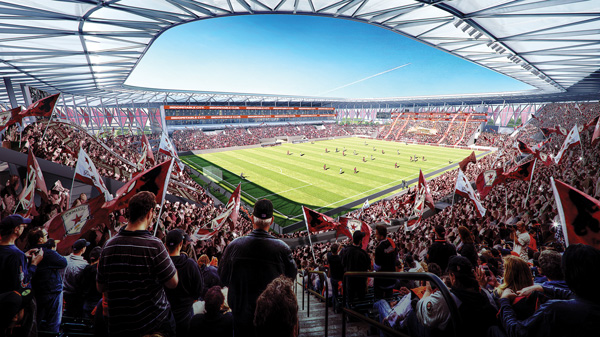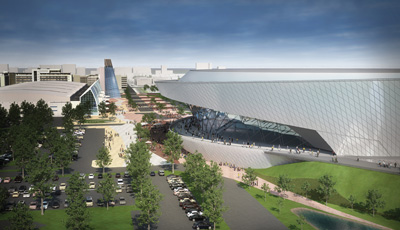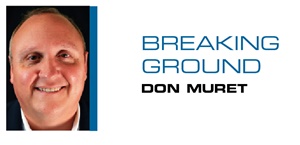Sacramento Republic FC’s selection of
HNTB to design its new stadium is a dream come true for a select group of designers involved in the project.
The $180 million development, which would be built if Major League Soccer allows the USL’s Republic to enter the league as an expansion team, marks the first MLS job for HNTB, an architecture firm whose sports portfolio covers mostly NFL and college football stadiums.
For Gerardo Prado, an HNTB vice president and its sports group director, it’s the first time he’s worked on a facility at the highest level of U.S. soccer in his 19 years at the company. Prado is an Argentina native who’s also lived in Costa Rica and Panama, and his first love is soccer. He now lives in the Kansas City area, coaches two of his three kids’ recreational soccer teams and takes them to several Sporting Kansas City games every year at Children’s Mercy Park.
 |
HNTB looked to the continuous bowls of German soccer stadiums in their design for a Sacramento MLS facility.
Photo by: SACRAMENTO REPUBLIC FC
|
Prado is not the only HNTB designer with an international background and a keen interest in soccer.
Alejandro Ogata, Sacramento’s senior project designer, is from Peru, where his grade school recess was always filled with short matches, called “pichangas,” using a makeshift ball made of socks.
“I was never a particularly great player but played it a lot nonetheless,” said Ogata, whose second job is teaching in the sports design studio at the University of Kansas. “It is impossible to escape. Futbol is king at home, and this [project] is an amazing opportunity.”
In addition, Scott Capstack, HNTB’s design principal in Sacramento, spent three years in Germany as the son of a 30-year Air Force veteran. Between the ages of 10 and 12, Capstack played organized soccer in Germany against local teams as well as in Belgium.
It adds up to a trio of architects with a deep passion and knowledge of the “world’s game” applying their overseas experiences to develop a stadium that’s influenced by soccer venues in Europe and South America.
For Sacramento Republic FC, they pushed for a seating bowl with a steep rake and no breaks in design. For premium seats, the 34 suites planned for the stadium will be placed at the top of the bowl on the west side, providing a much different setup from that of other MLS venues, where suites are close to field level, Prado said.
In Sacramento, the overall vision is to create a single wall of up to 20,000 fans in full voice, singing and chanting to provide a distinct home field that could potentially affect the outcome of the game.
“We have a lot of soccer knowledge internally, which all factored into our strategy, and it may have caught other design firms [competing for Sacramento] by surprise,” Prado said. “We didn’t want a split bowl. We wanted one pure to the sport, like the massive continuous bowls in Germany.”
Apart from its international ties, HNTB’s relationship with part of Sacramento Republic FC’s ownership group helped win the job. The firm designed Levi’s Stadium, the San Francisco 49ers’ facility that opened in August 2014. Less than six months later, in January 2015, the NFL team announced it had bought a stake in the Republic.
HNTB knew the local landscape. The firm designed Raley Field in Sacramento, a 15-year-old Class AAA ballpark, but officials did not pursue the soccer project until after the NFL franchise got involved as a team partner, Prado said.
“At that point, we got serious and felt this could be a transformative project for the city,” he said. “We felt we could probably win it based on the combination of our relationship with the 49ers and our international soccer experience.”
Ultimately, HNTB beat out HOK, the other finalist, confirmed Dale Koger, senior vice president and managing director for Legends, Sacramento’s owner’s representative. The fact that HNTB had never designed an MLS stadium came up in discussions between the team and Legends, but in the end, both parties thought a fresh, creative approach was the best way to move forward, Koger said.
“HNTB proved they were the right group for the project,” he said. “What they have done with the design to accentuate the branding of Sacramento Republic FC — incorporating elements of the star from the team logo into the exterior of the building — is some of the most natural creative design I have seen recently. And it is cost-effective.”
Should MLS tap the Sacramento market for expansion, a decision that could come this year, the stadium could potentially open in March 2018. The team will pay for two-thirds of construction costs with equity and will finance the balance of the project, according to local reports.
> GREEN SPACE: Minnesota United FC is working to make the move to MLS as well. But whereas Sacramento still needs MLS approval, Minnesota was awarded an expansion franchise by MLS last year, with stadium plans to follow.
What’s now on the board is a plan to build a 20,000-seat stadium.
Team officials hired Populous to design the facility and Mortenson to build it. For Minnesota-based Mortenson, builder of every major and minor league venue in the Twin Cities over the past 15 years, the soccer stadium represents its first MLS project.
The site for the $120 million stadium is an old bus barn on property owned by the Metropolitan Council, which runs regional public transportation services. It sits at the midpoint of downtown St. Paul and Minneapolis near three small colleges: Hamline, St. Thomas and Macalester. As a result, the demographics look good for attracting younger fans within a fairly affluent neighborhood, said Logan Gerken, Mortenson’s director of project development and a registered architect who was at Populous from 2007 to 2012.
 |
The proposed Virginia Beach arena would connect to the convention center.
Photo by: THE ESG COS.
|
> SUITE VIRGINIA: Mortenson is also part of a development team proposing to privately build a $200 million arena in Virginia Beach, Va., attached to the city’s convention center. Sports architect
AECOM and facility manager
SMG are also part of the team.
The lead developer is The ESG Cos., a firm tied to amusement parks, shopping centers and residential communities. In December, Virginia Beach City Council approved a deal to build the 18,000-seat venue that includes $76.5 million in public money to pay for infrastructure upgrades tied to the arena.
At that size, the project would stand out as the state of Virginia’s largest arena, running about 4,000 seats bigger than John Paul Jones Arena in Charlottesville and Richmond Coliseum, both of which are operated by SMG.
It’s Pinnacle Bank Arena in Lincoln, Neb., a publicly owned venue run by SMG and home to University of Nebraska men’s basketball, that’s serving as the model for Virginia Beach, according to Mortenson’s Gerken.
In Virginia Beach, the developer’s vision in part is to attract sporting events such as conference tournaments and NCAA tournament games that “currently bypass the region,” according to the project’s website.
The developer reportedly has had preliminary talks with the NHL, but to this point no primary tenant is committed to the arena development.
The initial design calls for roughly 20 to 40 suites, four party suites, 40 to 80 loge boxes, and 500 to 1,500 club seats, said Brittany Williams, project manager for The ESG Cos. The developer also plans to build retail and restaurant space attached to the facility.
Project officials are targeting a 2018 opening. Under its deal with the city, the developer must have the arena open by October 2019 or risk having the agreement terminated, Williams said.
> CASH FLOW: The Florida Panthers got an early holiday gift after Broward County officials in early December approved a modified operating agreement to provide the team with $86 million in public money to ensure its future in South Florida.
The deal includes $39 million in renovations to BB&T Center over the next 13 years, said Peter Luukko, the team’s executive chairman. The potential improvements include new retractable seating, roof replacement, new digital concourse signs, suite renovations and more wireless upgrades.
“We’re putting together a comprehensive plan,” Luukko said. “The concourse has a lot of original [backlit] sponsorship signs. We did some wireless upgrades for the NHL draft in June, but we still need better coverage in other areas.”
Don Muret can be reached at dmuret@sportsbusinessjournal.com. Follow him on Twitter @breakground.






